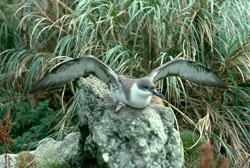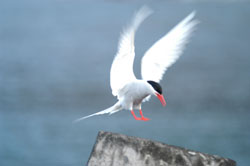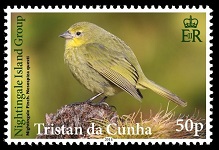Northern Rockhopper PenguinEudyptes crestatus moseleyi Known by Tristan Islanders as Pinnamins, Northern Rockhopper Penguins breed in rookeries throughout the Tristan archipelago. In fact 99% of the population breeds here. Rockhoppers are recognisable by the yellow tassels on the sides of their heads and their hopping gait when they move on shore. They are so characteristic of the islands that the islanders sometimes call themselves 'rockhoppers'. |
 |
 |
Albatross SpeciesSeveral species of albatross breed in the Tristan da Cunha Islands, some of which are endemic to the group. Then nest on mud pedestals and lay a single egg. Like all albatrosses, they are vulnerable to bycatch by long line fishing and are endangered species. They have an additional hazard on Gough Island, where invasive mice have evolved to predate their chicks. See also the 2013 Tristan Albatross stamp issue. |
Great Shearwaters or PetrelsThe great shearwater or petrel (Puffinus gravis) has a wingspan up to 118cm and weighs up to 1.1kg. It breeds in burrows up to 1.5 m long dug into peat and is strongly seasonal, returning to colonies from late August to lay single eggs in November which hatch in January and chicks fledge by May. |
 |
 |
Skuas and TernsAntarctic Terns (Sterna vittata tristanensis) or King Birds visit to breed on rocky ledges. The Tristan Skuas (Catharacta antarctica hamiltoni) are large brown gull-like birds that prey on other seabirds. They are endemic to the group, but breed mostly on Gough Island. Their numbers are reduced, but are not regarded as threatened. |
Land BirdsThere are seven land birds that are endemic to the Tristan group. All except the Tristan Thrush or Starchy (Turdus eremita - formerly Nesocichla eremita) are vulnerable or endangered. The Inaccessible Island Rail (Atlantisia rogersi) is the world's smallest flightless bird. The Gough Moorhen or Island Cock (Gallinula comeri) is also flightless. Apart from Gough, there is a small population on Tristan island, introduced in the 1950s, although there is a chance some extinct Tristan Moorhens G. nesiotis may have peristed. The four other endemic species are buntings, know locally as finches or canaries. See also the 2014 Tristan's Endemic Finches stamp issue. |
|

